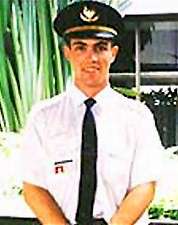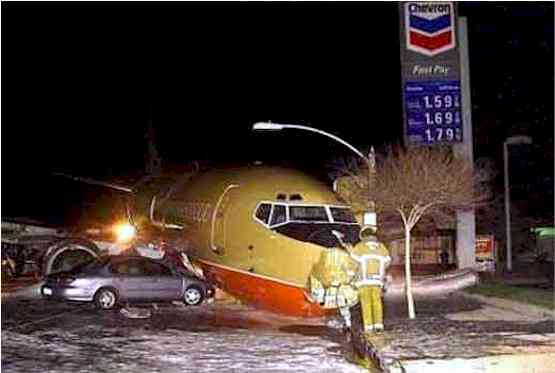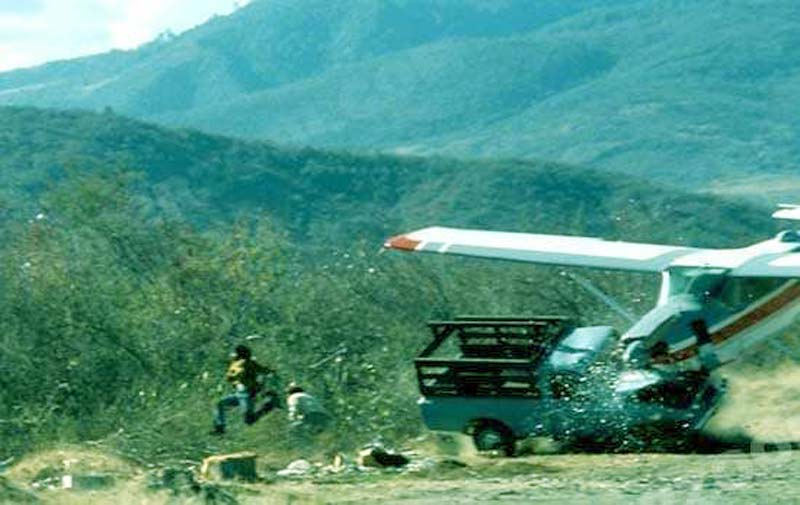Back to Earth
Down with a CrashThe three most useless things to a pilot are the altitude above you, the runway behind you and a tenth of a second ago. "Ma, I love yah." - last recorded words from PSA 182, after a fatal mid-air with a Cessna over San Diego, 25 September 1978. Excerpts from the Online Crash DatabaseDate: 31 October 1999
Date: 22 August 1999
"Ladies and gentlemen, thank you for choosing to fly with Mandarin Airlines. As we taxi out, please make yourselves comfortable.
Date: 23 July 1999 I wanted to soar through the air. - Yuji Nishizawa after hijacking All Nippon Airways flight 61
Date: 01 June 1999 Pilots' Error Blamed in Fatal Plane CrashWashington - The pilots' decision to land in a severe thunderstorm and their failure to set wing panels that would have helped slow the plane on the slick Little Rock, Arkansas runway caused a fatal airplane crash in 1999, a federal agency said yesterday. The National Transportation Safety Board said the pilots' actions aboard American Airlines Flight 1420 were not up to their usual standards and blamed the accident on their 14-hour workday and the stress they faced trying to land the plane in severe weather. The plane, heading from Dallas to Little Rock, crashed after overrunning the runway, killing 11 people, including the pilot. Another 105 people were hurt. The pilots decided to try to land in the thunderstorm, though they could have either waited out the severe weather, since they had enough fuel, or flown to another airport, the NTSB found. Source: The Star-Ledger Wednesday 24 October 2001
Date: 16 February 1998
Date: 19 December 1997 No Evidence Pilot Crashed SilkAir Plane - LawyersSingapore - A Singapore court hearing into an unexplained 1997 crash of a SilkAir plane resumed yesterday with the airline's lawyers maintaining there was no evidence to show that the pilot crashed the plane either intentionally or as a result of recklessness.
Families of six of the victims are suing the regional carrier for damages over the crash of Flight MI 185, which plunged into the Musi River on the Indonesian island of Sumatra en route from Jakarta to Singapore on 19 December 1997. The case was adjourned on 18 July so that both sides could prepare final written submissions. SilkAir's lawyer Lok Vi Ming told Supreme Court Justice Tan Lee Meng that the plaintiffs had not been able to prove the pilot or co-pilot had intended to commit suicide or had been reckless with the Boeing 737-300 knowing that it would cause damage. "The plaintiffs have not proved ... any factual evidence that would entitle either of these contentions to be maintained," Lok said. Lok said legal actions brought by some of the plaintiffs against Boeing and other aircraft parts manufacturers in the United States were "alternative contradictory allegations" to their case in Singapore. The plaintiffs' lawyer Michael Khoo painted a picture during an earlier hearing of an aircraft that was deliberately put into a nosedive by the pilot, Captain Tsu Way Ming. Air traffic controllers did not receive a distress call and investigators found that the plane's cockpit voice recorder and flight data recorder had stopped recording minutes before the plane went down - prompting rumours of pilot suicide. Indonesia's National Transportation Safety Committee said in its official crash report in December the highly fragmented wreckage "yielded no evidence to explain the cause of the accident". The plaintiffs are seeking a higher level of compensation from SilkAir, a regional carrier belonging to Singapore Airlines. Most families of the crash victims have already accepted compensation from SilkAir amounting to $US200,000 ($462,000) per victim which bars them from further legal action. Source: www.nzherald.co.nz from Reuters September 2001; photo is of co-pilot New Zealander Duncan Ward, who died in the crash
Date: 7 November 1996
Date: 2 October 1996
Date: 6 July 1996
Date: 11 January 1995
Date: 26 April 1994
Date: 23 March 1994 Source: www.crashdatabase.com
Prisoner Leaps from Police Plane at 4,200 FeetA prisoner being transferred from court to jail leapt 4,200 feet from a police plane into the icy waters off Canada. Donald Bigg, 46, was being taken from a court appearance on the Queen Charlotte Islands to a mainland jail when he grappled with a guard, opened an emergency door and plunged into the Hecate Strait. Canadian police said they did not believe he had taken a parachute with him and were treating the incident as a suicide. The coastguard service has been searching for his body, reports APB News. Source: www.ananova.com Saturday 9th December 2000
Pilot Knew Jet Landed Too Fast, Cockpit Transcript IndicatesThe most frequent last words I have heard on cockpit voice recorder tapes are, "Oh, shit," said about that much emotion. - Frank McDermott, partner in McDermott Associates, specialists in cockpit voice recorders
5 March 2000: This Southwest 737 came to rest at a Burbank, California gas by Alan Levin Documents Detail ErrorsWashington - The pilot of a Southwest Airlines flight into Burbank, California last year knew he had messed up. He had landed his 737 too fast, crashing through a fence at the end of the runway and skidding into a nearby gas station. "Well, there goes my career," Captain Howard Peterson said. Then, apparently speaking to himself, he said, "You stupid (expletive)." Tuesday, the National Transportation Safety Board (NTSB) released the cockpit voice recorder from the flight on 5 March 2000. The transcript indicates the pilots made numerous errors on their descent into Burbank-Glendale-Pasadena Airport near Los Angeles. None of the 142 passengers and crew aboard the flight from Las Vegas was killed. Seven people suffered minor injuries. Aviation experts, however, say the incident could easily have turned tragic. The pilots failed to perform mandated checklists and did not break off the landing, as their high speed and unstable descent required, according to NTSB documents released with the transcript. They also ignored a series of warning horns and sirens that sounded for 35 seconds before the landing. Just before touchdown at 6:11pm, a siren sounded and a mechanised voice commanded the pilots to pull up. At the same time, Peterson said, "That's all right." The jet's flight data recorder indicated the jet was travelling 209 mph at touchdown. A fully loaded 737-300 should land at about 160 mph, pilots say. Peterson, 53, and co-pilot J D Erwin, 44, could not stop the jet on the 6,032-foot runway. It tore through a fence, continued across a road and came to rest within feet of the gas pumps. As the jet skidded down the runway, Peterson cursed himself. Seconds later, after crashing though the fence, he said, "My fault. My fault." Four seconds later, he announced to the passengers, "Folks, remain seated, remain seated, we're all right." In Interviews with investigators, the pilots admitted making mistakes but said they believed they could slow the jet and land safely. Both pilots said that a 23-mph tail wind as they descended contributed to their high speed. Southwest fired Peterson and Erwin last July. But the airline relaxed the penalties after an internal grievance process, company spokesman Ed Stewart said. The airline allowed Peterson to retire without penalty. Erwin resumed flying after additional training and a one-month period in which a management pilot observed his flights. In Tuesday's release, the NTSB made public the factual reports of its investigative teams. The agency now begins work on concluding the cause of the accident. The agency raised other issues:
"Well, There Goes My Career"As Southwest Flight 1455 descended toward Burbank-Glendale-Pasadena Airport on the evening of 5 March 2000, warnings began sounding, according to transcripts released Tuesday by the National Transportation Safety Board. Captain Howard Peterson, who was flying the jet, and co-pilot J D Erwin continued to descend.
Source: USA Today 11 July 2001; photo credit Kevork Djansezian, Associated Press
Dead Pilot Cleared of BlameThere are no new types of air crashes - only people with short memories. If politics is the art of the possible, then air safety must be the art of the economically viable. - Stephen Barlay, The Final Call: Why Airline Disasters Continue to Happen March 1990 The skills of a 21-year-old pilot whose plane crashed in eastern Taranaki two years ago were praised in New Plymouth Coroners Court this week. Gerard Paul Child, 21, the pilot, and Shane Robert Alan Thompson, 22, his passenger, died in the crash early on Christmas Day 1999 near the Te Wera camp. The two friends were returning from Wellington to Rotorua after visiting Mr Thompson's father for Christmas. The plane burst into flames after the early morning impact. Coroner Roger Mori ruled that Mr Child and Mr Thompson died from injuries caused by the crash of the single-engined Cessna 172 at 2:50am on 25 December 1999. Despite Mr Child's youth, he had been thoroughly professional in handling the emergency, said Mr Mori. "A significant number of air accidents both in this country and overseas are caused in whole or in part by pilot error and I want to make it clear there was not the slightest hint of pilot error in this tragedy," he said. "He was faced with what must be a pilot's worst nightmare, namely the loss of an engine in a single-engined plane at night. It was clear he followed correct procedures, complied with the radio controller's request and dealt with the plane as best he could in a terrible emergency situation." A Civil Aviation Authority (CAA) investigation found the crash was caused by a broken connecting rod. Connecting rods join the piston to the crankshaft. Part of the broken rod was never found. Mr Thompson's mother, Roberta Booth, said on Monday that the family was not happy with the cause of the crash and believed there was sufficient evidence to sue. "We have made contact with Paul Davison, QC, in Auckland," she said. "We want to ensure that the safety precautions were taken." Mr Mori said the plane had been hired from an operator for whom Mr Childs was to start work as a pilot. It was clear from the CAA investigation that the failure of the plane was caused by the #6 connecting rod fracturing half way along the shank due to a pre-existing indentation, he said. How and when the indentation occurred could not be established. The plane had undergone a maintenance check just three days before the accident. The engine had been overhauled in September 1999. The crack in the rod appeared to have developed in the 59 hours of use since then, the CAA inspector said. The investigation led to a directive to the aviation industry to ensure inspection with a magnifying glass of the surface of each rod before reassembly and the rejection of any rod with nicks or dents and to take particular care not to damage surfaces, the court was told. - NZPA Source: The Dominion Wednesday 7 March 2001
One Way to Slow Your SpeedA "good" landing is one from which you can walk away. A "great" landing is one after which they can use the plane again.
See also:
To view other articles related to flying including history, unusual flying machines, hot air balloons, skydiving, gliding, problems, airports, turbulence, pilots, crashes, the
Paris Air Show, the future, blimps, space travel, solar sails and more, clicking the "Up" button below takes you to the Table of Contents for this section on Flight. |
 Animals
Animals Animation
Animation Art of Playing Cards
Art of Playing Cards Drugs
Drugs Education
Education Environment
Environment Flying
Flying History
History Humour
Humour Immigration
Immigration Info/Tech
Info/Tech Intellectual/Entertaining
Intellectual/Entertaining Lifestyles
Lifestyles Men
Men Money/Politics/Law
Money/Politics/Law New Jersey
New Jersey Odds and Oddities
Odds and Oddities Older & Under
Older & Under Photography
Photography Prisons
Prisons Relationships
Relationships Science
Science Social/Cultural
Social/Cultural Terrorism
Terrorism Wellington
Wellington Working
Working Zero Return Investment
Zero Return Investment
 Two New Zealanders, Duncan Ward,
23, the jet's co-pilot and Kenneth Wilson, 43, a passenger, were among the 104 who died in the crash.
Two New Zealanders, Duncan Ward,
23, the jet's co-pilot and Kenneth Wilson, 43, a passenger, were among the 104 who died in the crash.
